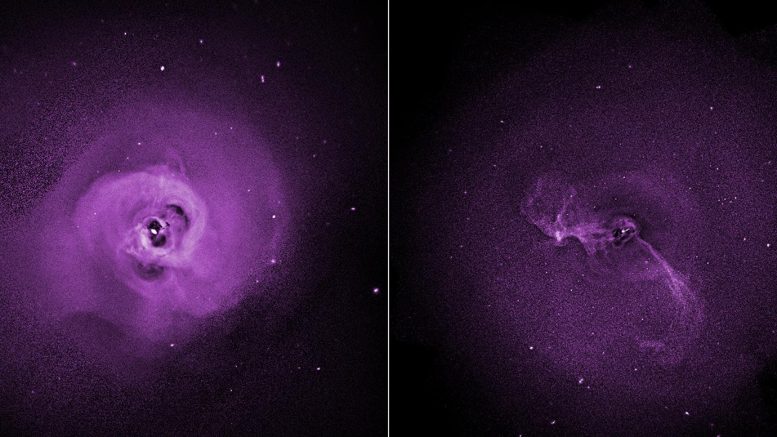
The X-ray Imaging and Spectroscopy Mission (XRISM) satellite, launched on September 6, aims to explore the universe’s hot plasma flows using advanced X-ray detection. (XRISM in space conceptual illustration.) Credit: JAXA
Data to reveal flows of matter and energy close to black holes and the elemental makeup of the universe.
On September 6, a new satellite departed Earth to tell us about the motions of hot plasma flows in the universe.
Launched from Tanegashima Space Center in Japan, the X-Ray Imaging and Spectroscopy Mission (XRISM) satellite will detect X-ray wavelengths with unprecedented precision to peer into the hearts of galaxy clusters, reveal the workings of black holes and supernovae, as well as to tell us about the elemental makeup of the universe.
XRISM, pronounced “crism,” is a collaborative mission between the Japan Aerospace Exploration Agency (JAXA) and NASA, with participation by the European Space Agency (ESA).
XRISM’s Unique Abilities
What sets XRISM apart from existing X-ray telescopes is its unique ability to distinguish different colors of X-ray light. This will unlock an extraordinary amount of information for scientists. It is equipped with a new type of instrument that detects X-rays through tiny temperature shifts. It will be able to identify what chemical elements are present in the object it’s looking at—like iron, nickel, oxygen, or silicon—as well as their abundances. XRISM will also be able to read the velocities of gas motions.
“With XRISM, we will have a whole new view of the hot and energetic universe,” said University of Chicago astrophysicist Irina Zhuravleva, who is a NASA participating scientist for the project and a chair of the diffuse extragalactic science team within the collaboration. “We will observe stellar explosions, interactions of black holes with their host galaxies, and violent mergers of galaxy clusters in unprecedented details, but most exciting—the unexpected discoveries that always accompany new missions.”
The Perseus (left) and Virgo (right) galaxy clusters have long been of interest to scientists. XRISM will build on these past observations (such as the images taken by Chandra X-ray Observatory, above) in order to better understand the physics at play in these massive objects. Credit: NASA/CXC/Stanford/I.Zhuravleva et al
Probing Extreme Phenomena
X-rays are produced by some of the most energetic and extreme phenomena in space. This includes exploding stars, the matter circling around supermassive black holes, and mergers of galaxy clusters – the largest objects in the universe containing thousands of galaxies tied by gravity.
Scientists at the University of Chicago will be analyzing the first observations of several massive galaxy clusters and galaxy groups. A big question relates to supermassive black holes, which sit in the centers of galaxy clusters. Scientists know these black holes release energy into the environment around them, which regulates the rate of star formation. But how exactly these black holes interact with their host galaxies remains an open question.
Irina Zhuravleva. Credit: Photo by Jean Lachat
“So far, we studied the physics of these interactions by looking at ‘static’ imaging data,” explained Zhuravleva, who is the Clare Boothe Luce Assistant Professor of Astronomy and Astrophysics. “With XRISM, we will measure velocities of gas motions driven by supermassive black holes and study the mixing of different gases and metals.”
Making similar measurements of the outer regions of galaxy clusters will also reveal how energy is transferred within the universe.
In addition, XRISM will precisely measure the abundances of different chemical elements and the distribution of metals within and outside galaxies—revealing what type of exploding stars are responsible for the current chemical makeup of the universe.
A New Frontier in Space Research
Because the Earth’s atmosphere blocks X-rays, these observations have to be made from space. Launching a satellite and controlling all the instruments from space is an extraordinary challenge. Three attempts have been made previously to launch and operate similar satellites but failed; scientists are hoping the fourth time is the charm for the mission’s success.
After its launch, the XRISM satellite will be tested and calibrated to ensure all instruments are ready to begin the observing program later this year.
“XRISM will open a new era of high-resolution X-ray spectroscopy,” said Zhuravleva. “We’re very excited about this mission and getting ready to analyze highly anticipated data.”
>>> Read full article>>>
Copyright for syndicated content belongs to the linked Source : SciTechDaily – https://scitechdaily.com/beyond-the-spectrum-xrism-launches-to-study-the-universe-in-different-colors-of-x-rays/

































